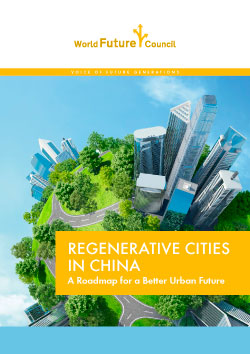This report “Regenerative Cities in China” was published on February 29, 2016 by the World Future Council. It’s based on contributions of urban planners, researchers, practitioners, city councillors and representatives of civil society and the private sector from around the world. The content of this report was developed following a series of Future of Cities Forums held yearly since 2011, and was specifically compiled
following the Future of Cities Forum 2015 in China in September of 2015.
The Future of Cities Forum 2015 was held in China on the 14th and 15th of September 2015 organized by the World Future Council (WFC), the United Nations Theme Group on Climate Change and Environment (UNTGCCE), the China Urban Research Center of Beijing Jiaotong University (BJTU) and supported by the All-China Environment Federation (ACEF), China (Binhai Tianjin) International EcoCity Forum & Expo, the Policy Research Center for Environment and Economy (PRCEE) of the Ministry of Environmental Protection (MEP) and CITYNET.
The first day of the Forum was hosted in Beijing as an official sub-forum of the 11th Forum on Environment and Development, and the second day of the Forum took place in Tianjin as a supporting activity of the 6th China (Binhai Tianjin) International EcoCity Forum & Expo. After briefly introducing some of the key opportunities for cities in relation to the Sustainable Development Goals and the Habitat III New Urban Agenda, this report outlines the most urgent challenges of sustainable urbanization in China. This report then summaries some of the key recommendations to overcome these challenges and to pave the way towards the creation of Regenerative Cities in China. In order to better elucidate certain aspects of urban development, further research was carried out and integrated with the material discussed during the Forum.
The upcoming two decades are critical for cities around the world. After the Sustainable Development Goals were ratified in September 2015 and a global agreement on cutting CO2 emissions was approved at the COP 21 in Paris, a New Urban Agenda is expected to be agreed at the Habitat III conference in October 2016 in Quito. As the international community increasingly emphasizes the crucial role of cities in leading the transition towards a more sustainable future, it cannot responsibly overlook the challenges of the most populated and intensely urbanized country in the world: China.
At the same time, Chinese authorities and stakeholders should not miss the chance to actively take part in these international processes both to ensure they have legitimate voice and input but also as an opportunity to learn and share their experiences with other countries. While it is undeniable that China benefited immensely from rapid economic growth and urbanization, particularly in terms of poverty alleviation and increase in standard of living, it also significantly suffered, especially from environmental burdens such as air pollution which is adversely affecting people´s lives and endangering the long term stability of the Chinese economy.
A new type of urbanization is therefore needed. This new kind of urbanization needs to reflect a different type of development, also known as the New Normal which is currently gaining widespread support throughout China. The New Normal understands the substantial changes affecting China (namely a decline in the availability of inexpensive land and cheap labour, slower economic growth and, above all, increasingly exacerbating environmental distresses) and responds by promoting a new kind of people-centred development that favours slower economic growth, people well-being, innovation, domestic market development and that is particularly devoted to environmental protection and sustainability.
In order to ensure the successful implementation of the New Normal, a new model of urbanization that encourages and supports this new type of socio-economic development is needed. It is hereby recommended that cities in China start their transformation to become Regenerative Cities. Given the environmentally degraded conditions of many Chinese cities and ecosystems, a regenerative type of urban development that is able to establish a symbiotic and mutually beneficial relationship with the environment is not only recommended but urgently needed.

